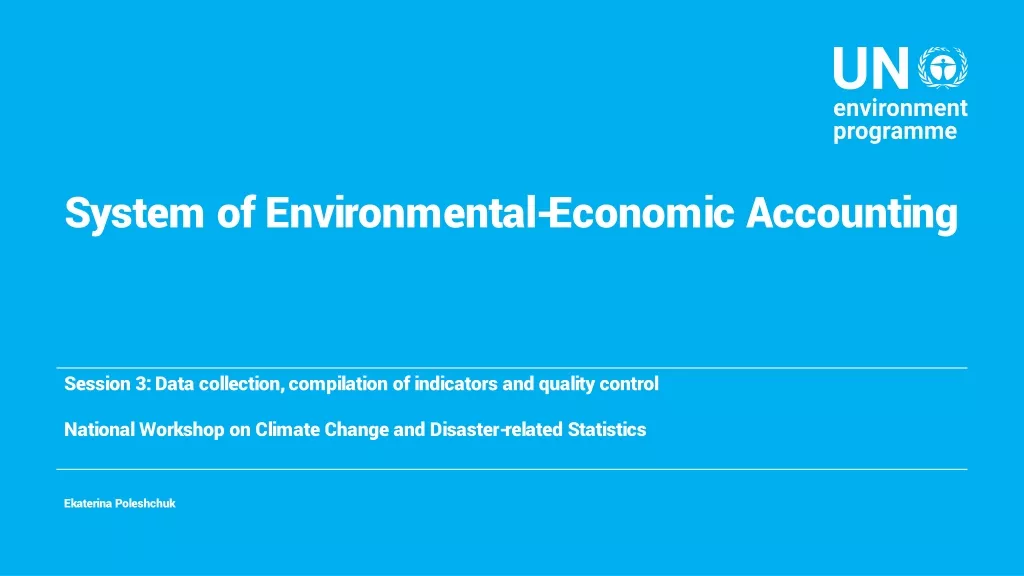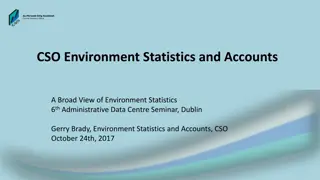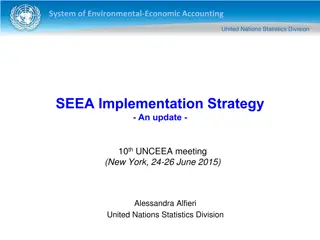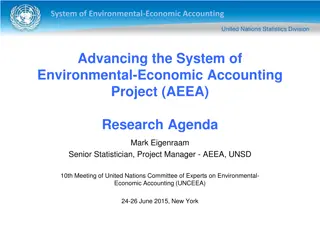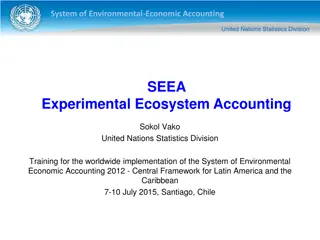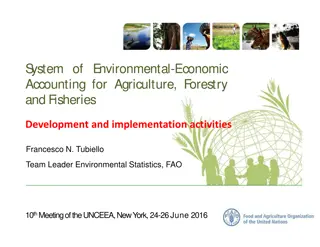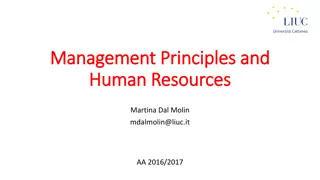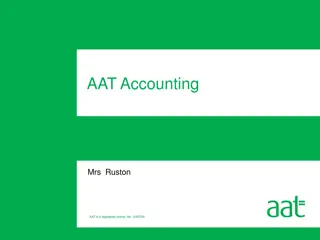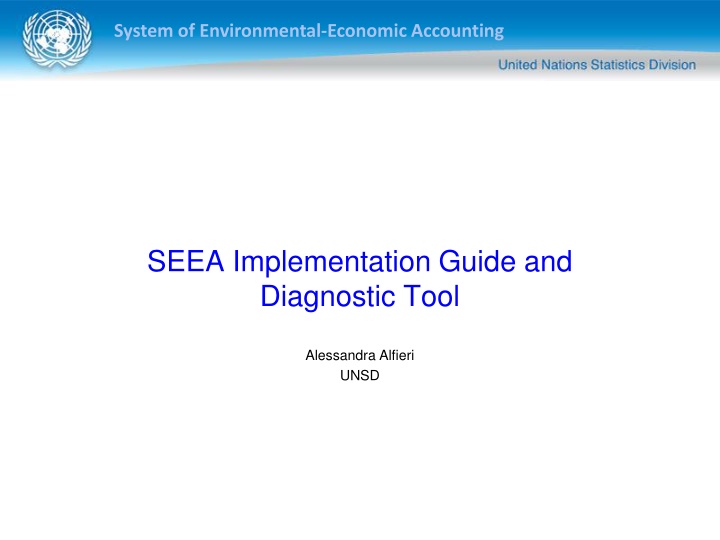
System of Environmental-Economic Accounting Implementation Guide
Comprehensive guide on implementing the System of Environmental-Economic Accounting (SEEA), outlining the nature, structure, phases, and diagnostic tools for effective deployment at the country level. It provides strategic planning, core group establishment, national assessment report completion, implementation mechanisms building, authorized senior board formation, team compilation and dissemination, and reinforcement of national statistical systems. The guide assists in addressing key implementation issues and risks while emphasizing the global context and country-specific considerations, facilitating a structured approach to adopting SEEA principles for environmental and economic assessments.
Download Presentation

Please find below an Image/Link to download the presentation.
The content on the website is provided AS IS for your information and personal use only. It may not be sold, licensed, or shared on other websites without obtaining consent from the author. If you encounter any issues during the download, it is possible that the publisher has removed the file from their server.
You are allowed to download the files provided on this website for personal or commercial use, subject to the condition that they are used lawfully. All files are the property of their respective owners.
The content on the website is provided AS IS for your information and personal use only. It may not be sold, licensed, or shared on other websites without obtaining consent from the author.
E N D
Presentation Transcript
System of Environmental-Economic Accounting SEEA Implementation Guide and Diagnostic Tool Alessandra Alfieri UNSD
System of Environmental-Economic Accounting Nature of the Implementation Guide Broad direction and support to national level implementation Introductory and overview document Works within the framework of the SEEA implementation strategy Recognise differences between countries and regions in actual situations and contexts Reflect lessons learned on implementation from past compilers Promote awareness of key implementation issues and risks
System of Environmental-Economic Accounting Structure of the Guide Introduction Rationale for implementation of SEEA Description of key elements of global implementation strategy Including international measurement programs Overview of implementation at country level Preparation of assessment reports and implementation plans Annexes Including Diagnostic tool, References
System of Environmental-Economic Accounting Four Phases of Implementation at Country Level Strategic planning Establishing a core group Completing a national assessment report Building mechanisms for implementation Authorised senior board or group Implementation team/s Compiling and disseminating accounts Strengthening national statistical systems
System of Environmental-Economic Accounting Diagnostic Tool Tool to support discussions on the implementation of SEEA particularly in initial assessments Eight areas in line with the logic of the implementation guide Order of areas a guide only
System of Environmental-Economic Accounting Initial statement of strategy
System of Environmental-Economic Accounting Draft outline (to be adapted as relevant ) Background Policy setting Stakeholders Relevant international, regional, bilateral programmes Current information/data available Constraints Opportunities Actions
System of Environmental-Economic Accounting Background National environmental and economic policy priorities linked to national programming and budgeting cycles Need for integrated information for evidence based policy making for sustainable development Link of national policy and statistical priorities to regional and international agenda Post-2015 agenda / SDGs / Broader measures of progress/WAVES/ UNEP TEEB
System of Environmental-Economic Accounting National policy setting and policy issues Main policy issues and instruments (regulations, fiscal, pricing, financial, trade, etc.) Environmental plans and strategies Sustainable Development Strategy National Policy for the Environment Management National Statistical Strategy National sector plans/strategy (energy, water, waste, etc.) National Biodiversity Strategy and Action Plan (NBSAP) National Policy for Climate Change Energy (renewable, energy efficiency) Deforestation Low carbon agriculture
System of Environmental-Economic Accounting National stakeholders Establish national coordination board/committee Identify national stakeholders: National Statistical Institutes Central Banks Ministry of Environment Ministry of Finance Water agencies/boards Ministry of Energy Ministry of Forestry .
System of Environmental-Economic Accounting International, regional and bilateral statistical and policy programmes relevant for the implementation of SEEA By way of example; Global programme on 2008 SNA implementation FAO global strategy for agriculture and rural statistics, pilot country Regional and subregional programmes Policy and analytical applications promoted by WAVES, TEEB and UNDP activities
System of Environmental-Economic Accounting Broad assessment of data availability Lots of data available ... But the data is not coordinated Electricity consumpti on and production Forestry Water resources Treated water Wastes Climate change vulnerability National accounts Agriculture Protection expenditur es Fish Ecosystem health Other data
System of Environmental-Economic Accounting Constraints and Opportunities
System of Environmental-Economic Accounting Constraints Data spread across national agencies and sections / not co-ordinated Project based statistics Limited data sharing or awareness of information Limited technical knowledge on environment statistics and accounts (water, forest, energy, etc.) and its linkage with economic statistics Lack of experience of the environment in economic policy making (e.g. use of policy instruments for fiscal and regulatory policy)
System of Environmental-Economic Accounting Opportunities Improve evidence based decision making in integrating environment/natural capital in development policies Improve quality of basic data sources (including the use of administrative records and official statistics) Reduce response burden and data collection duplication and increase cost efficiency/value for money in use of administrative sources and integration of business and household survey related collections and processing
System of Environmental-Economic Accounting Opportunities Strengthen institutional dialogue on policy and statistics Strengthen institutional coordination arrangements (e.g. Boards, MoUs. service agreements) for production of statistics and its policy use in support of compilation and policy use of SEEA Need to identify coordinator for statistics Objective to improve coordination
System of Environmental-Economic Accounting Actions Establish the national coordination board/committee with users and producers Prepare national statement of strategy Decide on priority accounts and related time series, indicators and policy applications Institutional arrangements (strategies and plans) Data quality assessment (following demands from strategies and plans)
System of Environmental-Economic Accounting Actions Pilot SEEA compilation (suggested as priorities like water, energy, forest, environmental protection expenditures, land cover/use) Plans by accounts: objectives, institutional arrangements, outputs, activities, sources, timelines, requirements for external assistance Dissemination and communication strategy on nationally agreed accounts and time series of statistics and indicators
System of Environmental-Economic Accounting Key Messages SEEA is a series of modules on different aspects of the environmental-economic relationship that can be compiled separately and incrementally integrated and improved Use SEEA as a catalyst to move towards integrated statistical system and mainstream environment in the statistical system Essential to undertake strategic planning with range of users and producers Invest in ongoing communication Aim to prepare accounts on an ongoing basis Release experimental or research data as part of building capacity and awareness learning by doing Share experiences and use international support
System of Environmental-Economic Accounting Table 4.1-Iimplementation Guide
System of Environmental-Economic Accounting Table 4.2-Implementation Guide

